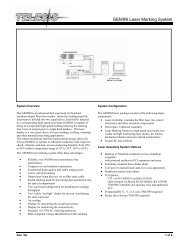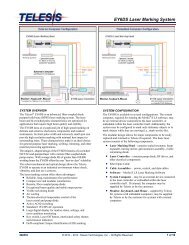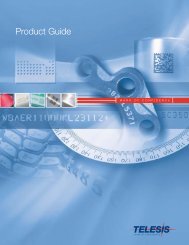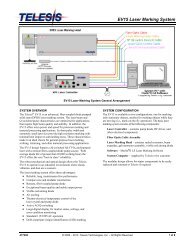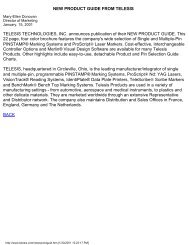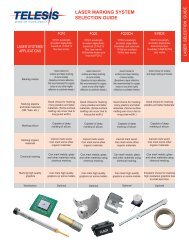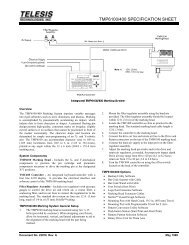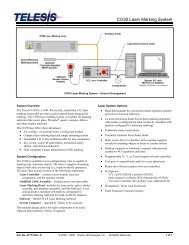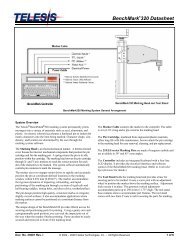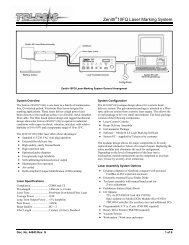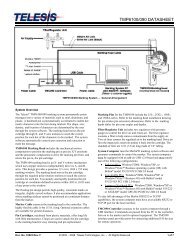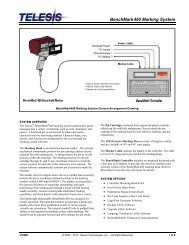TMP1700/090 DATASHEET - Telesis Technologies, Inc.
TMP1700/090 DATASHEET - Telesis Technologies, Inc.
TMP1700/090 DATASHEET - Telesis Technologies, Inc.
You also want an ePaper? Increase the reach of your titles
YUMPU automatically turns print PDFs into web optimized ePapers that Google loves.
System Overview<br />
The <strong>Telesis</strong> ® <strong>TMP1700</strong>/<strong>090</strong> PINSTAMP ® marking system<br />
permanently prints messages into a variety of materials such as<br />
steel, aluminum, and plastic. A hardened pin is pneumatically<br />
accelerated to indent dot matrix characters into the item being<br />
marked. The shape, size, density, and location of characters are<br />
determined by the user through the system software. The marking<br />
head moves the pin cartridge through X- and Y-axis motions to<br />
reach the correct position for each dot of the characters to be<br />
marked. The system software automatically controls pin extension<br />
and retraction to mark the message.<br />
<strong>TMP1700</strong> Marking Head is an X/Y-traversing mechanism. Using<br />
two stepper motor drives, it accurately and rapidly positions the pin<br />
at coordinate-defined locations in marking window within .001"<br />
(.025 mm). The <strong>TMP1700</strong> accommodates the rigorous dynamics of<br />
impacting, rebounding, and rapid positioning of the marking pin<br />
through a system of rigid rails and ball bearing saddles, timing<br />
belts, and direct-drive, toothed pulleys.<br />
The floating pin design permits high quality, consistent marks on<br />
irregular, slightly curved surfaces. It also accommodates<br />
applications where marking surfaces cannot be positioned at a<br />
consistent distance from the marker.<br />
The internal mechanism is protected from debris by an integral<br />
shield. Three stainless steel panels slide against one another,<br />
constrained by the cartridge and the high-impact ABS cover, to<br />
prevent debris from entering the marking head. A flexible, oilresistant<br />
fabric boot is also available for applications requiring<br />
additional protection, especially against liquid sprays and mists.<br />
Marker Cable, pre-wired to the marking head, connects the<br />
marker to the controller. The highly flexible cable is 4m (13 ft.)<br />
long. Optional extension cables are available for greater distances.<br />
Pin Cartridges, machined from plastic materials, offer long life<br />
with little maintenance. Clasps are used to attach the pin cartridge<br />
to the marking head for easy cleaning and pin replacement.<br />
<strong>TMP1700</strong>/<strong>090</strong> Marking System – General Arrangement<br />
<strong>TMP1700</strong>/<strong>090</strong> <strong>DATASHEET</strong><br />
Marking Pins for the <strong>TMP1700</strong> include the 25L-, 25XL-, 150S-,<br />
and 150SA-series, and the 10MP MICRO-PIN. Refer to the<br />
marking head installation drawing for pin stroke (pin extension)<br />
dimensions. Refer to the marking depth tables for pin cone angles<br />
and depths.<br />
Filter/Regulator Unit includes two regulators with pressure<br />
gauges to control the drive air and return air. The first regulator<br />
contains a filter to help remove contaminants from the supply air.<br />
Two air lines connect the regulated air to the marking head. Drive air<br />
fires the impact pin; return air pushes it back into the cartridge. The<br />
standard air lines are 12 ft. (3.6 m) long made of 1/4" tubing.<br />
System Computer runs the Merlin ® II marking system software and<br />
generates commands to control the marker. To take full advantage of<br />
the Merlin II RS232 or TCP/IP capabilities, the system computer must<br />
have an available RS232 or TCP/IP port for the host interface.<br />
Additionally, the system computer must be equipped with an add-on<br />
USB v2.0 board and must satisfy one of the following configurations:<br />
• Windows ® 2000 or Windows ® XP or Windows ® Vista<br />
Business operating system with Belkin ® model F5U219 PCI<br />
USB 2.0 board (full-size PCs);<br />
• Windows ® 2000 or Windows ® XP or Windows ® Vista<br />
Business operating system with Belkin ® model F5U219LP<br />
PCI USB 2.0 board (low-profile PCs);<br />
• Windows ® 2000 or Windows ® XP or Windows ® Vista<br />
Business operating system with Belkin ® model F5U222 or<br />
IOGEAR ® model GPU202 PCMCIA USB 2.0 board (laptop<br />
or notebook PCs).<br />
TMC<strong>090</strong> Controller connects to the system computer through a USB<br />
interface. Commands are passed from the PC to the controller, then<br />
on to the marker and its optional equipment. The TMC<strong>090</strong> interface<br />
panel provides ports for connecting additional I/O devices for<br />
remote operation.<br />
Doc. No. 33522 Rev. H © 2002 – 2009 <strong>Telesis</strong> <strong>Technologies</strong>, <strong>Inc</strong>. – All Rights Reserved 1 of 7
System Setup<br />
When designing a fixture, allow for 3-axis adjustment to aid in<br />
horizontal, vertical, and lateral alignment of the marking head.<br />
1. Mount marking head using two M6 bolts. Mounting bolts must<br />
extend into marking head no more than more 5/8" (15 mm).<br />
2. Mount filter/regulator assembly within 12 ft. (3.6m) of marker.<br />
3. Connect drive air and return air lines to the marking head.<br />
4. Connect supply air to input port on filter/regulator assembly.<br />
Note: The TMC<strong>090</strong> is not a sealed unit. Protect it from<br />
potentially damaging conditions and contaminants. Do<br />
not block case vents. Ensure the marking system is<br />
electrically isolated from any devices that may generate<br />
extreme electromagnetic interference (EMI).<br />
5. Locate controller as close as practical to marking head.<br />
Standard marker cable length is 4m (13 ft.).<br />
6. Ensure controller and PC power switches are OFF.<br />
7. Connect USB cable to controller and to PC.<br />
<strong>TMP1700</strong> Installation Drawing<br />
<strong>TMP1700</strong>/<strong>090</strong> <strong>DATASHEET</strong><br />
8. Connect marker cable from marking head to controller.<br />
9. Connect power cables to controller and to PC.<br />
10. Position PC power switch to ON.<br />
11. For customer-supplied PC, install marking system software.<br />
12. Position controller power switch to ON.<br />
13. Start marking system software.<br />
14. Adjust pin stroke, drive air, and return air for impact depth.<br />
System Options<br />
• Tool Post Assembly<br />
• Oil-resistant, Fabric Boot (debris protection for marking head)<br />
• Marking Head Extension Cables<br />
• Theta (Rotational) Axis and/or Z (Vertical) Axis<br />
• Bar Code Scanner or Bar Code Wand with Cable<br />
• Foot Switch (Start Print) or Pushbutton Station (Start/Abort)<br />
• Logo/Font Generator Software<br />
Doc. No. 33522 Rev. H 2 of 7
<strong>TMP1700</strong> Marking Head<br />
Specifications. The <strong>TMP1700</strong> marking head specifications are<br />
subject to change without prior notice.<br />
DIMENSIONS refer to <strong>TMP1700</strong> Installation Drawing<br />
WEIGHT 6.4 lb. (2.9 kg)<br />
OPERATING TEMP. 32° to 122° F (0° to 50° C), non-condensing<br />
AIR SUPPLY Clean and dry, 60 to 120 psi (4.2 to 8.3 bars)<br />
AIR CONSUMPTION .04 SCFM (idle) 0.6 SCFM (marking)<br />
MARKING AREA 2.5 x 1.5" (63 x 38 mm)<br />
PIN TYPES 10MP-, 25L-, 25XL-, 150S, or 150SA-series<br />
PIN MATERIAL Carbide (10MP-series MICRO-PIN)<br />
Powdered metal or stainless steel with diamond<br />
tip or carbide (25L-, 25XL-series)<br />
Powdered metal or tool steel with carbide tip<br />
(150S-, 150SA-series)<br />
Marking Characteristics. The <strong>TMP1700</strong> can produce characters<br />
as small as .030" (.76mm), printed at any angle within the marking<br />
window. Printing resolutions range from 10 dots per inch to 200<br />
dots per inch for an engraved look. The depth of mark can be<br />
adjusted over a significant range by adjusting the pin stroke and, to<br />
a lesser extent, by adjusting the drive air pressure.<br />
Marking Speeds. Generally, the system will mark four characters<br />
per second (using 5x7 font, .125" [3 mm] high characters). Speeds<br />
will vary slightly depending on the selected character size, style, and<br />
dot density. Specific times can be verified by a <strong>Telesis</strong> representative.<br />
Pin Life. Pin life depends largely on the type of material being<br />
marked, how hard or abrasive it is, and the required marking depth.<br />
On typical metals with a hardness of Rockwell Rb47, marking at a<br />
depth of .005" (.127 mm), powdered steel pins average about 3<br />
million impressions before needing sharpened; carbide pins average<br />
approximately 9 million impressions. If carbide pins are used,<br />
marking times will increase by approximately 25% due to the<br />
increased weight of the pins.<br />
<strong>TMP1700</strong>/<strong>090</strong> <strong>DATASHEET</strong><br />
Marking Depth. The following tables provide sample marking<br />
depths. Drive air was set at 80 psi (5.5 bars); return air was set at 20<br />
psi (1.4 bars); pin stroke was set to the maximum allowable<br />
distance for each pin type to achieve the maximum depth of mark.<br />
Marking Depths – Type 25L & 25XL Powdered-Metal Pins<br />
MATERIAL<br />
(HARDNESS)<br />
Aluminum<br />
(Rb3)<br />
Brass<br />
(Rb18)<br />
Cold Rolled Steel<br />
(Rc18)<br />
22°<br />
CONE<br />
.005 in.<br />
.127 mm<br />
.003 in.<br />
.076 mm<br />
.003 in.<br />
.076 mm<br />
30°<br />
CONE<br />
.007 in.<br />
.178 mm<br />
.005 in.<br />
.127 mm<br />
.005 in.<br />
.127 mm<br />
45°<br />
CONE<br />
.011 in.<br />
.279 mm<br />
.009 in.<br />
.229 mm<br />
.008 in.<br />
.203 mm<br />
60°<br />
CONE<br />
.016 in.<br />
.406 mm<br />
.012 in.<br />
.305 mm<br />
.012 in.<br />
.305 mm<br />
Marking Depths – Type 25L & 25XL Carbide Pins<br />
MATERIAL<br />
(HARDNESS)<br />
Aluminum<br />
(Rb3)<br />
Brass<br />
(Rb18)<br />
Cold Rolled Steel<br />
(Rc18)<br />
MATERIAL<br />
(HARDNESS)<br />
Aluminum<br />
(Rb3)<br />
Brass<br />
(Rb18)<br />
Cold Rolled Steel<br />
(Rc18)<br />
MATERIAL<br />
(HARDNESS)<br />
Aluminum<br />
(Rb3)<br />
Brass<br />
(Rb18)<br />
Cold Rolled Steel<br />
(Rc18)<br />
22°<br />
CONE<br />
.006 in.<br />
.152 mm<br />
.005 in.<br />
.127 mm<br />
.004 in.<br />
.010 mm<br />
30°<br />
CONE<br />
.007 in.<br />
.178 mm<br />
.007 in.<br />
.178 mm<br />
.005 in.<br />
.127 mm<br />
45°<br />
CONE<br />
.010 in.<br />
.254 mm<br />
.008 in.<br />
.203 mm<br />
.007 in.<br />
.178 mm<br />
Marking Depths – Type 150S Pins<br />
60°<br />
CONE<br />
.011 in.<br />
.279 mm<br />
.009 in.<br />
.229 mm<br />
.009 in.<br />
.229 mm<br />
Doc. No. 33522 Rev. H 3 of 7<br />
22°<br />
CONE<br />
30°<br />
CONE<br />
N/A .008 in.<br />
.203 mm<br />
N/A .007 in.<br />
.178 mm<br />
N/A .006 in.<br />
.152 mm<br />
45°<br />
CONE<br />
.012 in.<br />
.305 mm<br />
.010 in.<br />
.254 mm<br />
.008 in.<br />
.203 mm<br />
Marking Depths – Type 150SA Pins<br />
22°<br />
CONE<br />
30°<br />
CONE<br />
N/A .008 in.<br />
.203 mm<br />
N/A .007 in.<br />
.178 mm<br />
N/A .006 in.<br />
.152 mm<br />
45°<br />
CONE<br />
.012 in.<br />
.305 mm<br />
.010 in.<br />
.254 mm<br />
.008 in.<br />
.203 mm<br />
60°<br />
CONE<br />
.018<br />
.457 mm<br />
.017<br />
.432 mm<br />
.013 in.<br />
.330 mm<br />
60°<br />
CONE<br />
N/A<br />
N/A<br />
N/A
Marking Noise. When marking cold-rolled steel strips at 50%<br />
duty cycle, the noise level of the <strong>TMP1700</strong> Marking System has<br />
been measured at 74.6 dB, using the "time weighted average"<br />
approach (average sound exposure over an 8 hour period). It is<br />
expected that as the duty cycle rises, the time weighted average<br />
will rise also. Typical applications average around 20%-30% duty<br />
cycle where the sound pressure level would not exceed 70 dB (A).<br />
Noise-level Tests have been carried out under controlled conditions<br />
imitating as closely as possible predicted normal operation.<br />
Conditions such as rigidity of the work piece, material, setting of<br />
the machine, ambient noise, etc. may vary when in operational use<br />
and would alter the actual noise level.<br />
Despite detailed guidance notes provided with each machine, these<br />
conditions would be out of the control of <strong>Telesis</strong> and must remain<br />
the responsibility of the end user to conduct their own tests to<br />
establish safe working levels of use.<br />
<strong>TMP1700</strong>/<strong>090</strong> <strong>DATASHEET</strong><br />
Vibration Data. Vibration tests were performed under controlled<br />
conditions imitating, as closely as possible, typical normal operation.<br />
Conditions such as rigidity of the work piece, material, setting of<br />
the machine, etc. may vary in actual operational use and would<br />
alter the actual vibration level. Despite detailed guidance<br />
instructions provided with each machine, such conditions are<br />
beyond the control of <strong>Telesis</strong> and must remain the responsibility of<br />
the end user. Accordingly, you should conduct your own tests to<br />
establish safe working levels of use.<br />
The vibration tests were conducted using the following parameters:<br />
DRIVE AIR PRESSURE: 4.08 bars (60 psi)<br />
RETURN AIR PRESSURE: 1.36 bars (20 psi)<br />
PIN STROKE: 8 mm (.31 in)<br />
MARKING BASE: 20 mm (.79 in) thick steel<br />
MARKING SURFACES: 2 mm (.08 in) thick steel plate<br />
4 mm (.16 in) thick aluminum plate<br />
MARKING MODE: Dot<br />
TEXT MARKED: TELESIS<br />
(11x16 font, 5mm [.20 in] characters)<br />
HHHEEE000888<br />
(5x7 font, 3mm [.12 in] characters)<br />
The following test results reflect the worst-case scenarios under the<br />
given test conditions.<br />
Steel Marking Surface<br />
Pin VM T (EAV) T (ELV)<br />
25C 0.4 m/s 2 more than 24 hr more than 24 hr<br />
150SA 0.8 m/s 2 more than 24 hr more than 24 hr<br />
Aluminum Marking Surface<br />
Pin VM T (EAV) T (ELV)<br />
25C 0.6 m/s 2 more than 24 hr more than 24 hr<br />
150SA 1.2 m/s 2 more than 24 hr more than 24 hr<br />
where:<br />
VM = hand/arm vibration magnitude.<br />
T (EAV) = time to reach the Exposure Action Value based on<br />
continuous marking.<br />
T (ELV) = time to reach the Exposure Limit Value based on<br />
continuous marking.<br />
Doc. No. 33522 Rev. H 4 of 7
TMC<strong>090</strong> Controller<br />
Specifications. The TMC<strong>090</strong> specifications are subject to change<br />
without prior notice.<br />
DIMENSIONS refer to TMC<strong>090</strong> Installation Drawing<br />
RATING NEMA 1 (I.P. 30)<br />
WEIGHT 4.75 lb. (2.15 kg)<br />
OPERATING TEMP. 32° to 122° F (0° to 50°C ), non-condensing<br />
REQUIRED POWER 95-130 VAC, 2 amps, 50-60 Hz single phase<br />
200-250 VAC, 1 amp, 50-60 Hz single phase<br />
I/O VOLTAGE 12 to 24 VDC (customer-supplied)<br />
Interface Panel. The interface panel provides various ports for<br />
connecting the controller to the marking system equipment. The<br />
Marker port, USB port, and Aux Axis port are used to connect the<br />
marking head, system PC, and optional auxiliary axes, respectively.<br />
I/O control signals may be connected to the I/O port and the TTL<br />
Input port. (See I/O Control Signals.) RS-232 and TCP/IP<br />
communications may be connected to the PC and routed to the<br />
marker through the USB port. (See Host Communications.)<br />
TMC<strong>090</strong> Installation Drawing<br />
<strong>TMP1700</strong>/<strong>090</strong> <strong>DATASHEET</strong><br />
Environmental Considerations. The following environmental<br />
considerations must be taken into account when installing the<br />
TMC420 controller.<br />
Contaminants. The vented and fan-cooled TMC<strong>090</strong> is rated<br />
NEMA 1 (IP30). Accordingly, in environments where solid<br />
and/or liquid contaminants are present, the possibility exists that<br />
these contaminants can be drawn into the TMC<strong>090</strong> controller<br />
and possibly result in failure of a number of electronic<br />
components. For that reason, in these types of environments, the<br />
controller must be located in a sealed industrial enclosure.<br />
EMI Susceptibility. Although the system has been found to be<br />
in compliance with pertinent susceptibility standards, care<br />
should be taken when installing near welders and other extreme<br />
generators of electromagnetic interference (EMI). Particular care<br />
should be taken to ensure welder currents are not injected<br />
through the marking head chassis. The marking head chassis is<br />
connected to the electrical service earth ground through the<br />
marking head cable. The marking head should be electrically<br />
isolated from all surfaces which could become part of a welder<br />
current path.<br />
Doc. No. 33522 Rev. H 5 of 7
Merlin II Visual Design Software<br />
The marking system software runs on the system PC and connects to<br />
the controller via the USB port. It provides a 32-bit user interface to<br />
design pattern files and to operate the marker. The software is an<br />
easy-to-use, graphical-design application that provides tools for<br />
creating, saving, loading, and editing user-defined patterns. Each<br />
pattern contains one or more fields; each field defines a single object.<br />
Printable objects may be created to define text strings, arc-text<br />
strings, geometric shapes , graphics, and machine-readable data<br />
matrix symbols. Non-printable objects may be defined to specific<br />
commands to the marker (e.g., Pause, Go to, Input, or Output).<br />
Printable text fields may include alphanumeric characters, symbols,<br />
and special message flags. Message flags automatically insert data<br />
into the text string, such as serial numbers, times, dates and userdefined<br />
codes.<br />
I/O Control Signals. The TMC<strong>090</strong> is configured for DC I/O only.<br />
The TTL Input port may be used to connect a remote push button<br />
control for sending Start Print and Abort commands to the marker.<br />
The I/O port may be used to connect a PLC or other DC I/O source.<br />
The I/O port allows remote control of printing, aborting, placing<br />
the marker online, and monitoring of the Ready and Done output<br />
signals. Additionally, the I/O port allows for remote pattern<br />
selection. The marking system can monitor four separate input<br />
signals and, based on the on/off state of those signals, will select<br />
and open a specific pattern stored on the PC.<br />
Cable connectors and connector pins are supplied with the controller<br />
for constructing appropriate interface cables.<br />
START PRINT Input signal: begin print cycle<br />
SEL_0, 1, 2, 3 Input signals: pattern selection<br />
ABORT Input signal: abort print cycle<br />
INPUT COMM For all inputs (+ or – supply)<br />
READY Output signal: ready for message or start print<br />
DONE Output signal: print cycle complete<br />
OUTPUT COMM For all outputs (+ or – supply)<br />
<strong>TMP1700</strong>/<strong>090</strong> <strong>DATASHEET</strong><br />
Host Communications. The marking system software allows you to<br />
configure communication parameters to transmit and receive data to<br />
and from a host computer or a remote I/O device. The host<br />
communicates with the marking system software via the host<br />
interface on the system PC. The software passes information to and<br />
from the marking equipment via the controller USB interface. To<br />
provide maximum integration flexibility, the system software<br />
supports Ethernet (TCP/IP) interfaces and serial (RS-232) interfaces.<br />
It also provides two protocol choices: Programmable Protocol and<br />
Extended Protocol.<br />
TCP/IP Interface. The Ethernet (TCP/IP) interface is most often<br />
used with host computers communicating over a local area network<br />
(LAN). With this type of interface, you may use either Extended<br />
Protocol or Programmable Protocol.<br />
The Port parameter identifies the host computer socket that is<br />
assigned to the marking system. If more than one marking system<br />
is installed in a network configuration, each system must use a<br />
separate and unique port number. The Address parameter identifies<br />
the IP (Internet Protocol) address of the host computer. The<br />
marking system software supports both fixed addressing and<br />
dynamic addressing.<br />
RS-232 Interface. The serial (RS-232) communications interface<br />
is most often used with remote devices such as host computers,<br />
terminals, or bar code scanners. The RS-232 interface supports both<br />
Extended Protocol and Programmable Protocol.<br />
The following describes the serial data character format on all<br />
transmissions to and from the TMC<strong>090</strong> controller.<br />
• Asynchronous<br />
• 300, 600, 1200, 2400, 4800, 9600, 19200, 38400,<br />
57600, or 115200 Baud<br />
• 1, 1.5, or 2 Stop Bits<br />
• 5, 6, 7, or 8 Data Bits<br />
• None, Even or Odd Parity<br />
Doc. No. 33522 Rev. H 6 of 7
Programmable Protocol. Use this protocol where very simple<br />
one-way communications are required (such as with bar code<br />
scanners). Programmable Protocol provides no error checking or<br />
acknowledgment of the transmitted data. Note that XON/XOFF<br />
Protocol applies even when Programmable Protocol is selected.<br />
Starting Character specifies where the software begins to count<br />
character positions. This number must be entered in ASCII<br />
decimal format such as 2 for STX.<br />
Terminating Character identifies the end of transmitted string<br />
(usually ASCII carriage return character, decimal 13).<br />
Character Position counted from the starting character ignoring<br />
all characters preceding it.<br />
Character Length accepts variable length messages (if set to 0)<br />
or messages of a pre-specified, fixed number of characters.<br />
Ignore Character identifies the character to ignore when sent<br />
from the host (usually ASCII line feed character, decimal 10).<br />
Message Type allows message-type recognition which defines<br />
how the marking system will use data it receives from the host.<br />
49 (Type 1) overwrites first text field with data extracted from<br />
the host<br />
80 (Type P) loads a specific pattern identified by data extracted<br />
from host<br />
81 (Type Q) updates text in first query buffer with data extracted<br />
from host<br />
86 (Type V) updates first variable text field with data extracted<br />
from host<br />
0 (Type Zero) indicates that host will provide message type,<br />
field number (if applicable), and data; delegates message<br />
type selection to the host on message-by-message basis. The<br />
host message must use the format Tnn where:<br />
T = 1, P, Q, or V to indicate the message type.<br />
nn = two-digit number to indicate field number or<br />
query text buffer where data will be placed. Note<br />
that a number is not used with Message Type P.<br />
= field data (Message Types 1, Q, or V) or<br />
pattern name (Message Type P) , as applicable.<br />
Extended Protocol. This protocol selection includes error<br />
checking and transmission acknowledgment. It should be used in<br />
applications where serial communication is a vital part of the<br />
marking operation. All communications are carried out in a<br />
parent/child relationship with the host being the parent. Only the<br />
host has the ability to initiate communications. If the host does not<br />
receive a response within three seconds, it should re-transmit its<br />
original message. If no response is received after three tries, it should<br />
declare the link to be down.<br />
The following describes the Extended Protocol message format as<br />
sent from the host to the TMC<strong>090</strong> controller.<br />
SOH TYPE [##] STX [DATA TEXT] ETX BCC CR<br />
SOH ASCII Start of Header character (001H). The controller<br />
ignores all characters received prior to the SOH.<br />
<strong>TMP1700</strong>/<strong>090</strong> <strong>DATASHEET</strong><br />
TYPE A single, printable ASCII character that defines the<br />
meaning (type) and content of the message downloaded from the<br />
host, where:<br />
1 overwrites specified field of currently loaded pattern, using<br />
the data format nn where nn is the field number.<br />
P specifies pattern name to be loaded for printing<br />
Q updates specified query buffer with data received from host,<br />
using the data format nn where nn is the buffer<br />
number.<br />
V updates specified variable text field of currently loaded pattern,<br />
using the data format nn where nn is the field<br />
number.<br />
O resets marker and places it online<br />
G initiates a print cycle to mark the currently loaded pattern<br />
I requests the marker return the status of standard output and<br />
input signals in the hexadecimal format: O 2 O 1 ; I 2 I 1<br />
The first digit of the hexadecimal code reports the signal<br />
states of output signals Spare-3 and Spare-2. The second<br />
digit reports the states of output signals Spare-1, Spare-0,<br />
Pause, Ready, and Done.<br />
The third digit reports the signals states of input signals<br />
Select-4 and Select-3. The fourth digit reports the state of<br />
input signals Select-2, Select-1, Abort, and Go.<br />
[##] Two optional ASCII decimal digits that specify the Station<br />
ID number for use in multi-drop network applications. The ID<br />
may range from 00-31. Note that “00” is reserved for applications<br />
where only one controller is used. In such applications, this field<br />
may be eliminated and “00” will be assumed.<br />
STX ASCII Start of Text Character (002H).<br />
[DATA TEXT] Optional character string that may be required for<br />
certain message types (e.g., Type 1, P, Q, and V).<br />
ETX ASCII end of text character (003H).<br />
BCC Optional Block Check Code that is generated and sent to<br />
improve link reliability by providing fault detection. The BCC is<br />
calculated by taking an eight bit addition of the TYPE and DATA<br />
TEXT characters and transmitting them as a three digit ASCII<br />
decimal number in the range from 000 to 255. If the sum is greater<br />
than 255, the most significant bit overflows and is discarded.<br />
CR ASCII Carriage Return Character (00DH).<br />
TRADEMARKS<br />
<strong>Telesis</strong> and Merlin and PINSTAMP are registered trademarks of<br />
<strong>Telesis</strong> <strong>Technologies</strong>, <strong>Inc</strong>. in the United States and/or other<br />
countries.<br />
MICRO-PIN is a trademark of <strong>Telesis</strong> <strong>Technologies</strong>, <strong>Inc</strong>. in the<br />
United States and/or other countries.<br />
Belkin is a registered trademark of Belkin International, <strong>Inc</strong>.<br />
IOGEAR is a registered trademark of IOGEAR, <strong>Inc</strong>.<br />
Vista is a trademark of Microsoft Corporation in the United States<br />
and other countries.<br />
Windows is a registered trademark of Microsoft Corporation in the<br />
United States and other countries.<br />
Doc. No. 33522 Rev. H 7 of 7



